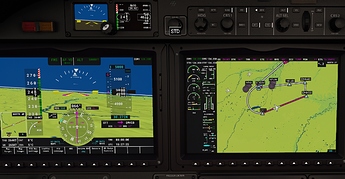Why would you deselect ALT exactly? Moving the heading bug has no effect as long as you are in NAV (GPS /FMS green) mode.
Assuming the RNAV approach is activated in the Garmin, the correct way is to fly direct to the final approach fix in NAV mode (GPS / FMS green, CDI magenta) and in ALT mode (ALT green). You could elect to descent and pick-up the GP without level off if you want as long as you hit the correct altitude at or before the FAF.
Using Approach (APR) mode:
When inbound the FAF, select APR, this will arm the GP mode (GP in white on the Garmin if I’m not mistaken). When established on the final track its good practice to select final approach track on the heading.
At the FAF the GP mode becomes green and starts following the magenta GP. As soon as this happens you can select go-around altitude in preparation for a go-around.
- Established on final approach track -> select runway heading.
- Established on GS or GP -> select missed approach altitude.
And thats all, you don’t have to deselect ALT, moving the heading bug does not do anything as long as you are not in HDG mode.
Using Vertical Speed (VS) mode:
If you want to fly an RNAV approach in VS mode (manually adjusting the vertical speed to maintain the magenta GP), the autopilot won’t allow you to descent below your selected altitude. You should first “unlock” the altitude by turning the selected altitude up by 300 ft.
So lets say altitude at FAF is 2000 ft, as soon as you reach 2000 ft and ALT mode is green, select 2300 ft, this will “unlock” the altitude. The autopilot will still maintain 2000 ft, but it will now allow descent.
At FAF (or slightly before), select VS, select the correct rate of descent. As soon as you are 300 ft below your missed approach altitude you can safely select missed approach altitude.
Selected Altitude
Just remember this, the autopilot (and flight director) will NOT allow you to climb or descent passed your selected altitude except:
- When using approach mode so GS or GP mode will trigger a descent from the selected altitude down to the runway.
- When “unlocking” the altitude by dialing the selected altitude through the current altitude. Just try to dial up the altitude during a descent or down during a climb through the current altitude and you will see the aircraft won’t level-off.
Knowing this consider this case: if you are high on the approach and you end up high at the final approach fix the autopilot won’t intercept the RNAV glidepath before reaching the selected altitude and will instead level off! Same is true for an ILS.
In other words, make sure you intercept the GS or GP before reaching the selected altitude.
Hope it helps.







